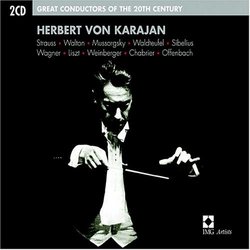| All Artists: Philharmonia Orchestra, Berlin Philharmonic Orchestra, Orchestra Sinfonica di Roma della RAI Title: Great Conductors of the 20th Century: Herbert von Karajan Members Wishing: 0 Total Copies: 0 Label: EMI Classics Release Date: 7/13/2004 Genres: Special Interest, Classical Styles: Marches, Opera & Classical Vocal, Ballets & Dances, Polkas, Historical Periods, Modern, 20th, & 21st Century, Romantic (c.1820-1910), Symphonies Number of Discs: 2 SwapaCD Credits: 2 UPCs: 724356286924, 072435628692 |
Search - Philharmonia Orchestra, Berlin Philharmonic Orchestra, Orchestra Sinfonica di Roma della RAI :: Great Conductors of the 20th Century: Herbert von Karajan
 | Philharmonia Orchestra, Berlin Philharmonic Orchestra, Orchestra Sinfonica di Roma della RAI Great Conductors of the 20th Century: Herbert von Karajan Genres: Special Interest, Classical |
Larger Image |
CD Details |
CD ReviewsFABULOUS bargain! WHAT a selection! Mark Shanks | Portland, OR | 12/08/2004 (5 out of 5 stars) "Don't hesitate - this is a bargain the likes of which seldom come along. The Walton Symphony #1 alone is worth the low price. Karajan (along with EMI producer Legge) spent time with Walton in the early 50's, and when Legge asked Karajan to record the Walton, he agreed, but had the nerve to ask Walton to RESCORE the piece! Walton, of course, declined. Karajan went on to perform it as a "work in progress" with the Orchestra Sinfonica di Roma della RAI in December 1953, not bothering to mention this to Walton. This recording is different than any other I've ever heard - maybe Karajan himself did some rescoring! For me, it is a fascinating piece of musical history, not really competition for the Previn recording but still full of vinegar. But wait! There's more! Another priceless gem: the 1953 Philharmonia recording of the Sibelius #4. Sibelius himself, after hearing THIS recording, pronounced Karajan as "the only conductor who understands the Fourth Symphonmy". Woah - take THAT Kajanus and Beecham! Add a wonder Liebestod from Tristan und Isolde, very snappy performances of Chabrier bob bons, a great "Pictures at an Exhibition", and still more - how can you resist? Even Karajan detractors will have to admit that this Karajan shines brightly and fiercely - not the legato-bound conductor of the late 70s but high energy and shining genius. Most highly recommended!" Early Karajan Joseph Reichmann | Los Angeles | 06/16/2008 (2 out of 5 stars) "This is a collection to pass. Poor sound in many spots and lethargic performances in most cases. The bon-bons are dreadful and flat. The Espana has no sparkle. Compared with Beecham or Ormandy...well..there just is no comparison. Pictures at an Exhibition is plain dull. Try Toscanini for this work. The Walton and Sibelius symphonies are the best selections in the set. However, there are many better performances available. Only hard core Karajan fans should consider buying this set. " Wonderful collection Sungu Okan | Istanbul, Istanbul Turkey | 01/28/2005 (5 out of 5 stars) "This new published recordings of Karajan are excellent. Except the Wagner recording (made in 70's) all records' dates from 50's and 60's, in other words middle ages of Karajan.
CD 1 starts with Johann Strauss's charming Tritsch-Tratsch Polka with Wiener Philharmoniker made in 1949 but sound quality is very good. And then there is a very interesting document: William Walton - Symphony No. 1 with RAI Orchesra Milan in a live concert and this the only Walton recording of Karajan. Even so it is comparable with Andre Previn's another sucessful version. At this recording Karajan is more wild, angry and his tempos more fast than his last years, may because of his youth. And a gem: Mussorgsky-Ravel: Pictures at an Exhibition with Philharmonia Orchestra made in 1955/6 but stereo. And again a wild performance, especially in Baba-Yaga movement, but even so, it is drammatic and poetic like in The Old Castle movement. It is really "must-have" recording for admirers of this masterwork. CD 2 begins with a famous and charming waltz: Waldteufel and Les Patineurs waltz, with Philharmonia. And then the most heavy work on entire recordings: Sibelius' Symphony No. 4 in A minor with Philharmonia made in 1953 monarual. This recording of 4th is one of the best versions ever made. Even so, Sibelius was listened this recording (he dead in 1957) and he declare Karajan to be "a great master". "Especially, his atristic line and the inner beauty of the interpretation have deeply impressed me". And then, one of the most romantic moments of the whole opera history: Wagner's Liebestod from Tristan with Helga Dernesch, who really really sung with emotion, very imressive and with Berliner Philharmonker. This work, especially at the last moments makes you will be weeping... And later, all of these records with Philharmonia Orchestra made in 1960. First, there is a brilliant work: Liszt's Hungarian Rhapsody (with sucessful orch. by Franz Doppler). And then, one of Karajan's most favourite encore pieces: Jaromir Weinberger's Polka form the opera "Svanda the Bagpiper". This is really brilliant and charming music. And then, the French romantic composer E. Chabrier's most famous works: Espana (rhapsody) and Joyeuse March. These works recorded lovely. And the last piece is a very romantic piece: Offenbach's Barcarolle form "Les Contes de Hoffmann". Still Karajan is really good at like this slow and romantic pieces. In other words: at this price this is a must-have recording for all Karajan admirers and classical music lovers. Highly recommended." |
